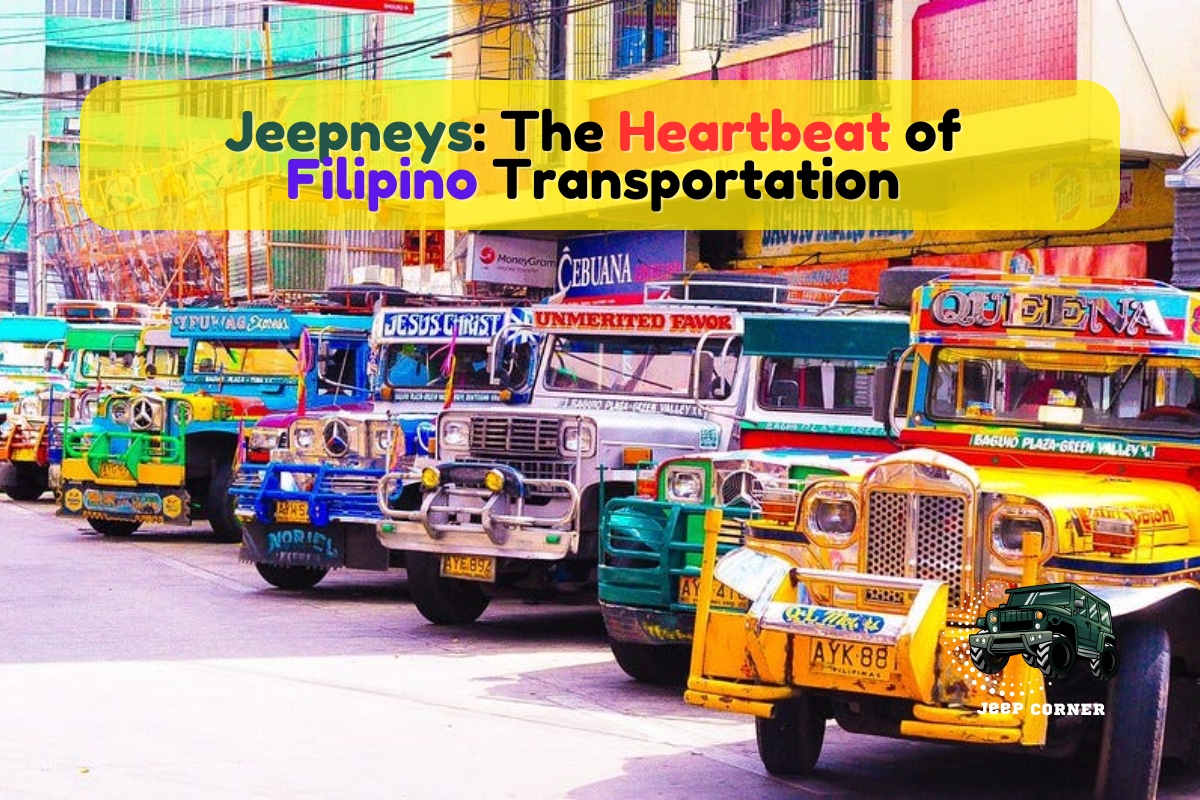Jeepneys: The Heartbeat of Filipino Transportation – Tradition, Pros, and Cons
In this report, I present a comprehensive analysis of the jeepney—a vehicle that has transcended its utilitarian purpose to become a cultural icon in the Philippines. I delineate its historical origins from U.S. military surplus after World War II, its evolution through local ingenuity and artistic expression, and the modern pressures and government interventions shaping its future. My analysis draws on diverse learnings that capture historical transformations, cultural symbolism, operational characteristics, regional design variations, and the modern socio-economic and environmental challenges faced under the Public Utility Vehicle Modernisation Program (PUVMP).
Table of Contents
Historical Background and Transformation
I trace the origins of jeepneys to the immediate post-World War II era:
- Post-WWII Military Surplus:
- Surplus U.S. military vehicles—particularly Willys and Ford jeeps—were left behind in the Philippines.
- Local Filipinos repurposed these vehicles to serve as public transport by:
- Extending the chassis to accommodate additional passengers.
- Adding metal roofs to provide protection from the elements.
- Removing military insignias and practically redesigning the structure for civilian use.
- Initial Modifications:
- The conversion process involved stripping down original components and reconstructing the seating arrangement to hold up to 15–16 passengers.
- Early adopters painted and adorned their vehicles with colorful designs, using the metal body as a canvas, and integrating symbols such as the iconic horse emblem reminiscent of the era of horse-drawn carriages.
- Key Historical Milestones:
- The seminal work by local innovators, such as Leonardo Sarao (founder of Sarao Motors in 1953), played a pivotal role in standardizing jeepney production while simultaneously catalyzing regional design variations.
The Pros of Jeepneys
Jeepneys are more than just a mode of transportation—they are a lifeline for millions of Filipinos. Here are some of their key benefits:
- Affordability:
- Jeepneys are one of the most cost-effective ways to get around, making them accessible to people from all walks of life.
- Fares are significantly lower compared to taxis or ride-hailing services, ensuring that even low-income commuters can travel affordably.
- Accessibility:
- Jeepneys operate on fixed routes, connecting urban centers, rural areas, and everything in between.
- Their flexibility in picking up and dropping off passengers along the way makes them a convenient option for daily commuters.
- Cultural Significance:
- Jeepneys are a symbol of Filipino creativity and resilience, showcasing vibrant designs, religious symbols, and pop culture references.
- They are a moving testament to the country’s history and identity, earning them a special place in Filipino hearts.
- Community Building:
- The close seating arrangement fosters a sense of camaraderie among passengers, creating a unique social experience.
- Jeepney stops often serve as community hubs where people gather, interact, and support local businesses.
Cultural Significance and Artistic Expression
I emphasize that jeepneys are not merely a mode of public transportation; rather, they encapsulate the spirit of Filipino ingenuity, resilience, and community:
- Symbol of Ingenuity and Resilience:
- The jeepney is a testament to Filipino resourcefulness. The ability to repurpose military surplus into functional and culturally vibrant vehicles highlights the community’s creative response to economic constraints.
- It embodies the concept of bayanihan—a spirit of communal support and cooperation—exemplified by the communal experience aboard these vehicles.
- Artistic Identity and Cultural Canvas:
- Each jeepney is often personalized with:
- Vibrant, eclectic color schemes.
- Intricate patterns that incorporate religious imagery, pop culture icons, indigenous motifs, and regional narratives.
- I note that the jeepney’s artistic customization has invited both scholarly and cultural interest, as evidenced by artworks such as Vicente Manansala’s “Jeepneys” and numerous grassroots protest art initiatives.
- Each jeepney is often personalized with:
- Regional Variations:
- Urban Centers (e.g., Metro Manila): Typically feature modern amenities (e.g., free Wi-Fi, GPS) alongside vivid artistic designs tailored to contemporary cultural narratives.
- Rural Areas (e.g., Cebu, Bohol, and Mindanao): Often retain more utilitarian features, with adaptations made from locally available vehicles such as Suzuki minivans or Isuzu Elf trucks, combined with regional artistic themes.
- Cultural Protest and Counter-Narratives:
- The jeepney also functions as an instrument for socio-political expression:
- Movements like #NoToJeepneyPhaseout leverage jeepney art to protest modernization policies perceived as a threat to cultural heritage.
- Prominent Filipino artists (e.g., Ya’kub Ira, Jerome Noveras, Jenn Ban, and Chi Chai) use multidisciplinary media to challenge colonial histories and articulate grassroots activism.
- The jeepney also functions as an instrument for socio-political expression:
Socio-Economic Role of the Jeepney
I detail how jeepneys are interwoven with the economic fabric and daily social interactions of millions of Filipinos:
- Public Transportation Lifeline:
- Servicing as the primary mode of transport for millions, jeepneys facilitate approximately 9 million rides daily in Metro Manila and support around 600,000 drivers nationwide.
- They offer flexibility in routing and pedestrian access, which, while beneficial to commuters, can create challenges for regulated traffic systems.
- Economic Implications:
- Jeepney operations are typically managed by independent drivers rather than large corporations—a structure that has both spurred entrepreneurship and heightened intra-route competition.
- The economic significance is resonant in the numerous jobs created not only in direct vehicle operation but also in manufacturing, maintenance, and the artistic industries that continuously upgrade their aesthetics.
- Community and Social interaction:
- The close seating design promotes interaction among passengers, fostering community bonds and social cohesion.
- Jeepney stops often serve as community hubs where local commerce and informal exchanges take place.
Modernization Efforts and Contemporary Challenges
I now turn to the complexities introduced by government-led modernization initiatives, notably the Public Utility Vehicle Modernisation Program (PUVMP):
- Goals of the PUVMP:
- The program aims to reduce environmental pollutants and traffic congestion by transitioning from outdated diesel engines to more environmentally friendly electric and hybrid models.
- Specific improvements include:
- Installation of Euro 4-compliant engines.
- Enhanced safety features such as CCTV, GPS monitors, speed limiters, and automated fare collection systems.
- Increased comfort for passengers with features like higher ceilings, dual side doors, optional air-conditioning, and tap card payment systems.
- Economic and Operational Challenges:
- The cost differential is stark:
- Traditional jeepneys are priced between PHP 200,000 and PHP 400,000.
- Modern jeepneys can cost from PHP 1.3–1.5 million locally and up to PHP 2.8 million for imported models.
- Government subsidies have been modest:
- Initial subsidies covered only about 5% of costs.
- More recent measures increased assistance (e.g., PHP 280,000 as of December 2023) yet remain insufficient for a complete transition.
- Loan programs available via institutions like the Development Bank of the Philippines and Land Bank of the Philippines offer financing at roughly 6% per annum, presenting further financial challenges for operators.
- The cost differential is stark:
- Social and Cultural Dilemmas:
- Modernization debates are polarized:
- Proponents underscore safety, environmental benefits, and improved efficiency.
- Criticisms revolve around the erasure of the jeepney’s cultural identity and the loss of livelihoods for traditional drivers, further complicated by fears of fare hikes and inequitable cooperative mandates.
- I observe that this modernization effort has instigated grassroots movements and protest art, forming counter-narratives that emphasize the cultural heritage and socio-economic role of the jeepney.
- Modernization debates are polarized:
- Implementation Metrics:
- The PUVMP has instituted strict deadlines:
- Operators must consolidate by set deadlines (e.g., compliance milestones extended to 30 April 2024 in some regions, with complete compliance required by the end of 2023 in certain areas).
- Jeepneys older than 15 years are facing phase-out mandates, challenging traditional operators who depend on older models.
- The PUVMP has instituted strict deadlines:
- Projected Urban Impact:
- Urban areas like Metro Manila suffer from economic losses estimated at PHP 3.5 billion daily due to traffic bottlenecks.
- Projections suggest a potential increase of up to 2.25 times in vehicle numbers by 2035 alongside a 125% rise in daily transport trips—factors that compel urgency in modernizing the fleet despite inherent challenges.
Comparative Summary Table
To encapsulate the multifaceted dimensions of the jeepney’s evolution, I have prepared the following table:
| Dimension | Traditional Jeepneys | Modernized Jeepneys |
|---|---|---|
| Origin | Repurposed surplus U.S. military vehicles post-WWII | Redesigned under government programs (PUVMP) |
| Cost | PHP 200,000–PHP 400,000 per unit | PHP 1.3–1.5 million locally; up to PHP 2.8 million imported |
| Cultural Expression | Highly individualized with vibrant regional art, iconography, and personalized designs | Attempt to maintain iconic elements while meeting modern standards |
| Operational Features | Side-facing bench seats; flexibility in picking up passengers along non-designated stops | Front-facing seats; advanced safety protocols (CCTV, GPS, automated fare collection) |
| Environmental Impact | Outdated diesel engines with higher emissions | Euro 4-compliant / electric/solar-powered units reducing pollutants |
| Economic Role | Supports millions in daily commuting; largely driver-operated | Risk of job displacement; higher operational costs balanced with lower maintenance expenses |
| Policy & Regulatory Framework | Informal operator structures; minimal state intervention | Mandated cooperative structures; loan financing and subsidies provided by the government |
Reflections on Cultural Preservation versus Modern Efficiency
I find that the challenge is not solely technical or economic but profoundly cultural:
- Heritage vs. Innovation:
- The jeepney is a moving repository of Filipino heritage, reflecting decades of localized artistic evolution. The move to modernize these vehicles brings with it a risk of losing unique design elements that many consider irreplaceable cultural expressions.
- I view the modernization debate as a dialectic between the need for progress—environmentally and economically—and the desire to preserve cherished cultural identities.
- Community Impact:
- Beyond mere transportation, jeepneys contribute to the social fabric and communal interactions of the Filipino people. Initiatives such as jeepney karaoke and artisan miniatures for souvenirs testify to their enduring cultural influence.
- Grassroots initiatives, such as protest art campaigns (#NoToJeepneyPhaseout) and community festivals (e.g., the 2024 Be Free Festival in the SOMA Pilipinas district), illustrate the dynamic reception of modernization policies and serve as platforms for public discourse on heritage preservation.
- Technological and Financial Adaptations:
- I also recognize innovative opportunities arising from this transition:
- Adoption of electric technology may spur advancements in battery technology and green infrastructure.
- Cooperative management models, though challenging, may ultimately lead to a more sustainable and professionally managed public transport ecosystem.
- I also recognize innovative opportunities arising from this transition:
Remarks
I assert that the jeepney stands as both an engineering marvel of post-war ingenuity and a potent cultural symbol of the Filipino identity. Its journey from repurposed U.S. military jeeps to elaborately decorated mobile art pieces—and now into the era of modern electric vehicles—embodies the multifaceted tensions between tradition and modernity.
I appreciate the complexity of balancing environmental sustainability and operational efficiency with the preservation of a cherished cultural heritage. Policymakers, industry stakeholders, and cultural custodians must work collaboratively to ensure that modernization does not lead to the erasure of the unique socio-cultural narrative that jeepneys represent.
My analysis, informed by historical documentation, socio-economic data, and cultural studies, suggests that a nuanced approach—one that integrates both technical upgrades and robust cultural preservation measures—could serve as a blueprint for transforming the public transportation landscape without sacrificing heritage.
The Cons of Jeepneys
Despite their cultural and practical significance, jeepneys face several challenges:
- Environmental Impact:
- Many jeepneys run on outdated diesel engines, contributing to air pollution and greenhouse gas emissions.
- Their fuel inefficiency makes them a less sustainable option in the face of growing environmental concerns.
- Safety Concerns:
- Overloading, lack of maintenance, and outdated designs can compromise passenger safety.
- The absence of seatbelts and other safety features increases the risk of accidents.
- Traffic Congestion:
- Jeepneys often stop frequently and unpredictably, contributing to traffic jams in busy urban areas.
- Their large numbers and slow speeds can exacerbate congestion, especially during peak hours.
- Modernization Challenges:
- The government’s push for modernization, including the phase-out of old jeepneys, has sparked debates about the loss of cultural heritage.
- Many drivers and operators struggle to afford the high costs of upgrading to modern, eco-friendly vehicles.
The Future of Jeepneys
The future of jeepneys is at a crossroads, balancing tradition with the need for progress:
- Modernization Efforts:
- The Public Utility Vehicle Modernization Program (PUVMP) aims to replace old jeepneys with electric or hybrid models.
- These modern jeepneys feature improved safety standards, better fuel efficiency, and reduced emissions.
- Government Support:
- Subsidies and loan programs are being introduced to help drivers and operators transition to modern vehicles.
- However, the high costs of new jeepneys remain a significant barrier for many.
- Cultural Preservation:
- Efforts are being made to retain the artistic and cultural elements of jeepneys in modern designs.
- Grassroots movements and protest art campaigns, such as #NoToJeepneyPhaseout, highlight the importance of preserving this cultural icon.
- Sustainable Solutions:
- Electric jeepneys (e-jeepneys) are emerging as a promising alternative, offering a cleaner and more sustainable option.
- Innovations in battery technology and renewable energy could further enhance their viability.
Jeepneys: The Heartbeat of Filipino Transportation – Tradition, Pros, and Cons
There’s something magical about the first time you step into a jeepney. The burst of colors, the hum of the engine, and the camaraderie of strangers squeezed together in a moving work of art—it’s an experience that stays with you. I still remember my first ride: the warm breeze brushing my face, the driver’s friendly nod, and the rhythmic clinking of coins being passed from hand to hand. It wasn’t just a ride; it was a journey into the heart of Filipino culture.
Jeepneys are more than just a mode of transportation—they’re a symbol of resilience, creativity, and community. Born from the ashes of World War II, these repurposed military jeeps have become the lifeblood of the Philippines, carrying millions of Filipinos to their destinations every day. But as much as they are beloved, jeepneys are also at a crossroads, facing challenges that threaten their future.
In this blog, I’ll take you on a ride through the tradition, pros, and cons of jeepneys, sharing stories, insights, and stunning photos that capture their essence. Whether you’re a curious traveler, a culture enthusiast, or someone who’s never heard of a jeepney, buckle up—this is a journey you won’t want to miss.
The Tradition of Jeepneys
The jeepney is more than just a vehicle—it’s a cultural icon of the Philippines, a rolling testament to Filipino creativity and resilience. Born from the remnants of U.S. military jeeps left after World War II, these vibrant, artfully decorated vehicles have evolved into a symbol of ingenuity, connecting communities and carrying the stories of millions of Filipinos.
I’ll never forget my first jeepney ride: the kaleidoscope of colors, the rhythmic hum of the engine, and the sense of camaraderie as passengers squeezed together, passing coins down the row. It wasn’t just a ride; it was a journey into the heart of Filipino culture.
In this blog, I’ll take you on a deep dive into the world of jeepneys—exploring their rich tradition, the benefits they bring to daily life, and the challenges they face in a rapidly modernizing world. Along the way, I’ll showcase stunning photos that capture their vibrant designs and undeniable charm. Whether you’re a curious traveler, a culture enthusiast, or someone new to the world of jeepneys, this is a ride you won’t want to miss.
The Pros of Jeepneys
Jeepneys are more than just a mode of transportation—they are a lifeline for millions of Filipinos. Here are some of their key benefits:
- Affordability:
- Jeepneys are one of the most cost-effective ways to get around, making them accessible to people from all walks of life.
- Fares are significantly lower compared to taxis or ride-hailing services, ensuring that even low-income commuters can travel affordably.
- Accessibility:
- Jeepneys operate on fixed routes, connecting urban centers, rural areas, and everything in between.
- Their flexibility in picking up and dropping off passengers along the way makes them a convenient option for daily commuters.
- Cultural Significance:
- Jeepneys are a symbol of Filipino creativity and resilience, showcasing vibrant designs, religious symbols, and pop culture references.
- They are a moving testament to the country’s history and identity, earning them a special place in Filipino hearts.
- Community Building:
- The close seating arrangement fosters a sense of camaraderie among passengers, creating a unique social experience.
- Jeepney stops often serve as community hubs where people gather, interact, and support local businesses.
The Cons of Jeepneys
Despite their cultural and practical significance, jeepneys face several challenges:
- Environmental Impact:
- Many jeepneys run on outdated diesel engines, contributing to air pollution and greenhouse gas emissions.
- Their fuel inefficiency makes them a less sustainable option in the face of growing environmental concerns.
- Safety Concerns:
- Overloading, lack of maintenance, and outdated designs can compromise passenger safety.
- The absence of seatbelts and other safety features increases the risk of accidents.
- Traffic Congestion:
- Jeepneys often stop frequently and unpredictably, contributing to traffic jams in busy urban areas.
- Their large numbers and slow speeds can exacerbate congestion, especially during peak hours.
- Modernization Challenges:
- The government’s push for modernization, including the phase-out of old jeepneys, has sparked debates about the loss of cultural heritage.
- Many drivers and operators struggle to afford the high costs of upgrading to modern, eco-friendly vehicles.
The Future of Jeepneys
The future of jeepneys is at a crossroads, balancing tradition with the need for progress:
- Modernization Efforts:
- The Public Utility Vehicle Modernization Program (PUVMP) aims to replace old jeepneys with electric or hybrid models.
- These modern jeepneys feature improved safety standards, better fuel efficiency, and reduced emissions.
- Government Support:
- Subsidies and loan programs are being introduced to help drivers and operators transition to modern vehicles.
- However, the high costs of new jeepneys remain a significant barrier for many.
- Cultural Preservation:
- Efforts are being made to retain the artistic and cultural elements of jeepneys in modern designs.
- Grassroots movements and protest art campaigns, such as #NoToJeepneyPhaseout, highlight the importance of preserving this cultural icon.
- Sustainable Solutions:
- Electric jeepneys (e-jeepneys) are emerging as a promising alternative, offering a cleaner and more sustainable option.
- Innovations in battery technology and renewable energy could further enhance their viability.
Conclusion
The jeepney is more than just a vehicle—it’s a symbol of Filipino ingenuity, resilience, and community. From its humble beginnings as a repurposed military jeep to its status as a cultural icon, the jeepney has played a vital role in shaping the Philippines’ transportation landscape.
However, as the country moves toward modernization, the jeepney faces significant challenges. Balancing the need for progress with the preservation of cultural heritage is no easy task, but it’s one that must be addressed with care and collaboration.
As we look to the future, let’s celebrate the jeepney’s legacy while embracing sustainable solutions that honor its past and pave the way for a brighter tomorrow. Whether you’re a lifelong fan or a curious newcomer, the jeepney’s story is one worth riding along for.



![Can Jeep Wrangler Tow 5000 LBS? [Find Out The Truth]](https://jeepcorner.com/wp-content/uploads/2023/11/Can-Jeep-Wrangler-Tow-5000-LBS-768x448.png)




